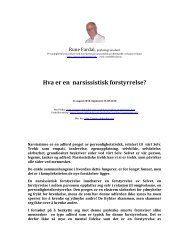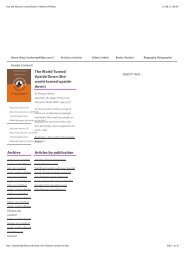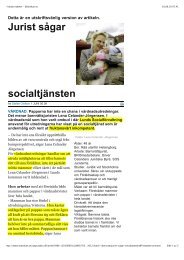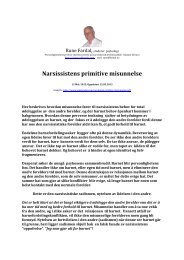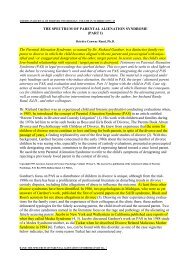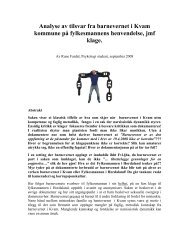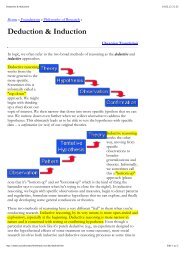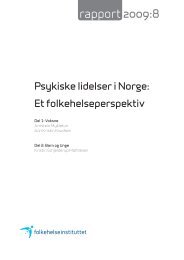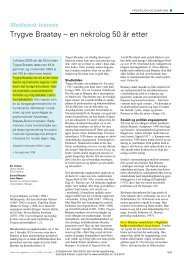The origins of narcissism and narcissistic personality disorder a
The origins of narcissism and narcissistic personality disorder a
The origins of narcissism and narcissistic personality disorder a
Create successful ePaper yourself
Turn your PDF publications into a flip-book with our unique Google optimized e-Paper software.
THE ORIGINS OF NARCISSISM 53<br />
resentation <strong>and</strong> object representations) are undifferentiated. This developmental<br />
period was thus characterized as one without libidinal<br />
investments in or even knowledge <strong>of</strong> objects. Freud’s first theory <strong>of</strong><br />
<strong>narcissism</strong> survives, to some extent, in his later writings <strong>and</strong> can be<br />
glimpsed in the statement, ”<strong>The</strong> ego is first <strong>and</strong> foremost a bodily ego;<br />
it is not merely a surface entity but is in itself the projection <strong>of</strong> a surface”<br />
(Freud, 1923/1961, p. 26). Even with this partial survival <strong>of</strong> his earlier<br />
theory, however, Freud’s final word on the subject cannot be clearer:<br />
It is hard to say anything about the behavior <strong>of</strong> the libido in the id<br />
<strong>and</strong> in the super-ego. All that we know about it relates to the ego,<br />
in which at first the whole available quota <strong>of</strong> libido is stored up.<br />
We call this state absolute, primary <strong>narcissism</strong>. It lasts until the ego<br />
begins to cathect the idea <strong>of</strong> objects with libido; to transform <strong>narcissistic</strong><br />
libido into object libido. Throughout the whole <strong>of</strong> life the<br />
ego remains the great reservoir from which libidinal cathexes are<br />
sent out to objects <strong>and</strong> into which they are also once more withdrawn,<br />
just as an amoeba behaves with its pseudopodia. It is only<br />
when a person is completely in love that the main quota <strong>of</strong> libido<br />
is transferred onto the object <strong>and</strong> the object to some extent takes<br />
the place <strong>of</strong> the ego. (1940/1964, pp. 150-151)<br />
In this later model, which regards <strong>narcissism</strong> as the initial stage <strong>of</strong><br />
development, autoerotism is no longer regarded as a developmental<br />
period in its own right but instead as a mode <strong>of</strong> libidinal satisfaction<br />
that is characteristic <strong>of</strong> <strong>narcissism</strong> but that can also be activated later<br />
in life (Freud, 1915/1957).<br />
If, furthermore, <strong>narcissism</strong> ultimately involves an initial lack <strong>of</strong> investment<br />
in objects, it also implies an initial lack <strong>of</strong> knowledge <strong>of</strong> them.<br />
Specifically, Freud’s writings suggest that infants, their functioning organized<br />
by a <strong>narcissistic</strong> structure termed the purified pleasure-ego<br />
(Freud, 1915/1957), are inclined not even to discover objects, let alone<br />
to invest in them, <strong>and</strong> would not become aware <strong>of</strong> the environment<br />
if they could satisfy themselves autoerotically. Freud (1900/1953;<br />
191 1/1958a) held that infancy is a period <strong>of</strong> hallucinatory wish-fulfillment<br />
(see also Ferenczi, 1913/1950). In other words, infants, when<br />
faced with mounting physiological tension-<strong>and</strong> hunger is the paradigmatic<br />
tension state in this regard-hallucinate the object that will<br />
satisfy their needs or wishes <strong>and</strong> relinquish this mode <strong>of</strong> gratification<br />
only when, after repeated frustration, they discover that the halluci-




